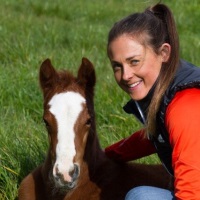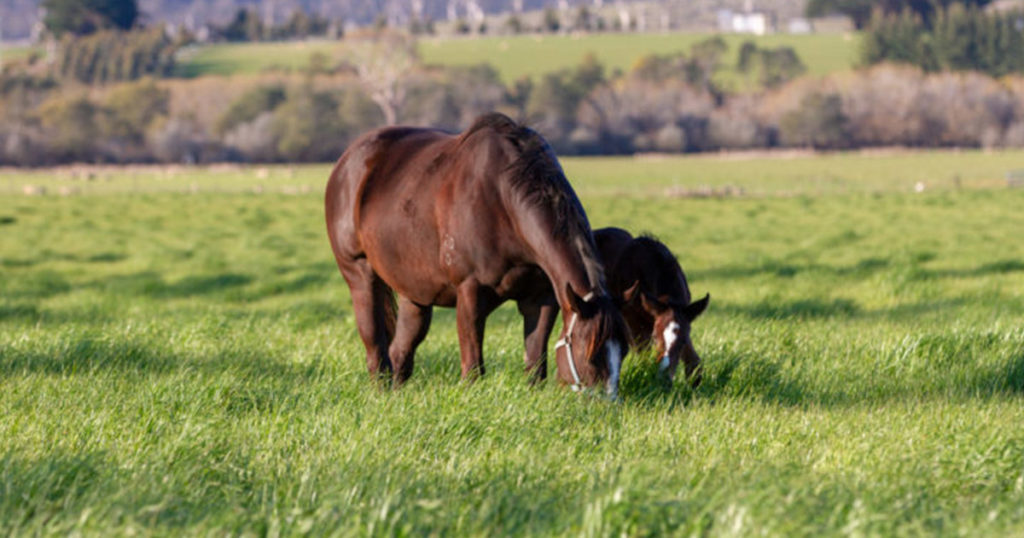For those of you who ride mares and/or fillies you may have noticed somewhat erratic changes in her mood and behaviour during spring. The mare who was steadfast and easy going over the winter months may have at times started to become irritable, anxious, ‘girthy’, aggressive and painful or sensitive around her flanks. Gait abnormalities and a reluctance to being ridden may also occur. Excluding injury or an underlying medical condition, it is highly likely that this behaviour is related to her oestrus cycle.
The Oestrus Cycle in the Mare
Horses are seasonal breeders: that is, they are programmed to mate and become pregnant at certain times of the year. Over the winter months, the majority of mares (particularly those in temperate climates) are anoestrus- meaning they don’t cycle. As daylight hours increase over the spring and leading into the summer, hormonal changes occur in the body, acting as a stimulus for them to become reproductively active. Nutrition and climate also play an important role in influencing a mare’s oestrus cycle. Some mares appear to cycle all-year round (this is more likely in far-north Australia).
Early in spring, as a mare transitions from aneostrus to cycling, the timing of when she comes into heat may be prolonged or erratic, with accompanying unpredictable behaviour. As the season progresses, the mare’s cycle should become more regular: having three week cycles. The average oestrus cycle of a mare is 21 days, which can be divided into two distinct phases: the oestrous phase (when a mare is ‘in heat’ and receptive to a stallion; and the dioestrous phase (when a mare is generally not receptive to a stallion). The oestrous phase usually lasts somewhere between 5-7days. At this time, the hormone oestrogen is at a high level, and this is the period often associated with changes in behaviour in susceptible mares. The dioestrous phase is generally lasts for 14-16 days, characterised by high levels of the hormone progesterone and a mare generally having little or no receptivity to a stallion.
It is these two female sex hormones- oestrogen and progesterone which strongly influence behaviour patterns demonstrated by many mares and fillies during the breeding season. Most commonly, a mare who is susceptible to displaying ‘mareish’ behaviour will demonstrate this behaviour during the oestrous phase, in associating with elevated oestrogen levels. It is important to remember though that there are always exceptions to this- especially in mare’s/fillies who have erratic cycles.
Important Considerations
Before concluding that a mare or filly’s behaviour patterns are purely related to her oestrus cycle, it is important to ensure that there are no significant other contributing factors. As in all animals, horse behaviour is comprised of several components, including: innate (genetic); learned (environmental); pain-associated behaviour; and sexual (hormonal). Keeping this in mind, it is important to remember that some behavioural problems are the results of genetics, injury/illness, poor training and/or past bad experiences.
Additionally, some diseases can result in behaviour that appears very similar to what many mares experience during the breeding cycle. An ovarian tumour can cause consistently high levels of oestrogen, which may cause the mare to be constantly ‘in season’. Bladder infections can cause a mare to raise her tail and urinate frequently; and injury, nerve impingement or arthritis in the spine or hind legs can result in a mare frequently squatting down. These are all signs that may be typical of a mare in season, with only subtle differences. For these reasons, ongoing behavioural issues should be thoroughly investigated by a vet to rule out illness or injury.
Natural strategies and treatments to managing behaviour in the oestrous cycle
For the healthy mare whose signs are purely related to hormonal changes (having excluded other conditions/reasons mentioned above), there are many useful dietary, nutritional and herbal strategies which can be employed.
It is of upmost importance to remind owners/riders of mares and fillies that many of these horses who experience sensitivity to physical touch during their cycle are actually experiencing some degree of pain or cramping, similar to many human women! Hence some care and compassion are called for, and appropriately addressing and rectifying this through the use of nutritional and herbal strategies is invaluable.
Dietary and management strategies aim at reducing excessive oestrogen levels during the oestrous period- thereby helping to reduce classic signs associated with the dominance of this hormone. Keeping a mare at a healthy weight and avoiding becoming overly fat is one of the first considerations. Fat tissue itself acts as an endocrine organ (meaning it produces hormones), and commonly results in the production of high oestrogen levels and inflammatory mediators, thereby aggravating behavioural symptoms, in addition to cramping and pain. Another important dietary consideration is keeping the mare/filly on a nutritional program which stabilises blood-glucose levels, thereby keeping the levels of insulin (another hormone) balanced. Generally, a diet which is high in roughage and low in refined grains, starches and added sugars can help to meet all of the above goals. Ensuring the diet has sufficiently high omega-3 fatty acids and proportionally lower levels of omega-6 fatty acids is important. For the horse with high energy requirements, additional sources of healthy fats may be used to meet these needs. The importance of balancing feed intake with appropriate exercise cannot be over-stated: physical activity plays an important part in weight management; regulating blood glucose and insulin levels; and keeping inflammatory mediators at healthy levels. Cooked and/or crushed linseed is a beautiful addition to the diet: helping to balance inflammatory mediator levels; providing a rich source of dietary lignans (which can help to reduce excessive oestrogen levels); and helping to promote a healthy coat and skin (thanks to the high oil content).
Nutritional supplements can be a most valuable addition on several fronts when aiming to promote health and happiness in the hormonal mare! Strategic use of appropriate nutrients can help to reduce inflammation; minimise spasm and cramping; and optimise blood glucose and insulin levels. Depending on the individual horse, these can include: high quality fish oils; magnesium; B group vitamins; vitamin C and chromium. As with any nutritional supplementation, professional consultation should be sought to ensure safety and efficacy.
Herbal medicines are a most effective form of treatment in holistically managing a hormonal mare. When prescribed appropriately, herbs such as Vitex and White Peony can help to regulate a mare’s cycle, aiding in ‘normalising’ behaviour, balancing oestrogen and progesterone levels and reducing spasmodic cramping and associated sensitivity to touch (think of the mare who hates her flanks being touched or leg pressure applied when in season). Additionally, the herbs Ginger, Sarsaparilla and Cramp Bark are incredibly effective at modulating inflammation, cramping and associated pain when in season. For the mare who still remains somewhat edgy and irritated, Chamomile, Vervain and Valerian can be incredibly useful. As with any herbal prescription, seek professional, qualified advice to ensure the safety, efficacy and appropriate use of such herbs. In particular, the use of hormone modulating herbs (such as several of those mentioned above) need to be strictly monitored. Several of the herbs previously mentioned also have restricted use in some forms of competition.
Mares and fillies can be some of the toughest and most competitive horses. A little understanding of the oestrus cycle, how to best manage it, and effective strategies for those horses that become ‘out of sorts’ during this time can go a long way to achieving the results you are after, not to mention having a happier, more co-operative horse!

Camilla Whishaw is a highly regarded, experienced horsewoman and naturopath, helping to holistically treat and manage a broad range of equine health conditions and injuries, with a passion for mare and stallion fertility.
As a world-renowned practitioner, presenter, author, and consultant in the field of Equine Naturopathy, Camilla shares her knowledge through keynote presentations, interviews, lectures, panel sessions, and workshop training.





